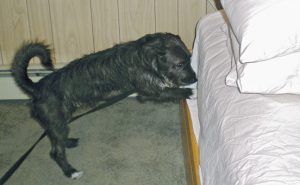-
Trained bed bug scent detection dogs can search many rooms and large areas with surprising accuracy.
-
Results for some areas may be ambiguous, but proper follow-up can ensure the integrity of the inspection.

“Finn,” a scent detection dog for Rose Pest Solutions, alerts on scent when he encounters bed bugs.
Photo: Mark Sheperdigian, BCE
A trained canine scent detection team can search dozens of rooms or many office cubicles in a matter of hours, and detect the presence of bed bugs with a high degree of accuracy. Certain conditions may confound the dogs through scent movement or other distractions, but an experienced handler can reduce the uncertainty by flagging the ambiguous locations.
It helps to know a little bit about how the dogs work, and where they work best. If we clear up a few myths, it becomes easier to understand the results of canine inspection.
1. See vs. smell
The most basic concept is that the dogs do not “find” bed bugs; they detect scent. Air currents can whisk the scent up and out of reach of even the most exquisite noses. The scent of a single bug hidden deep in the surroundings may show up as a fleeting whiff. The dog may change behavior, but if properly trained, it will not alert if it cannot identify a source. A good handler understands this, and can help out by guiding the search.
2. Location, location, location
Once an alert has been given, a cursory inspection can often confirm the location of the bugs. If the bugs cannot be found, it may be due to one of several reasons. Scent can be lifted by convection currents and may pool in another part of the room, causing an alert. The scent may come from a single bug — or even an egg — that cannot be found by even the most observant inspector. While there are a number of factors that can confound a canine inspection, most inspections are straightforward. Accurate results can be rendered with surprising speed.
3. Following through
When drug and bomb detection dogs alert, the authorities are able to “deconstruct” a car or vessel to find hidden or disguised contraband. We do not deconstruct furniture to find a single bug, but that is not our only option. An alert with no visual confirmation is not a reason to apply a pesticide, but should be followed by one of several responses. A follow-up inspection from a trained professional may be able to find the bugs once they know where to look. Monitors can be deployed to see whether any bugs can be trapped. Tenants hate waiting. At a facility or multi-unit housing, inspect adjacent units — scent from heavy infestations next door can be conveyed to the canine’s sensitive nose.
Proper follow-up to canine inspections can complete the inspection process to quickly identify infestations when large buildings or many apartments need to be searched. A full complex sweep is essential to properly begin a program for multi-unit housing.
Contributor Mark Sheperdigian, BCE, can be reached at shep@rosepest.com.
Leave A Comment